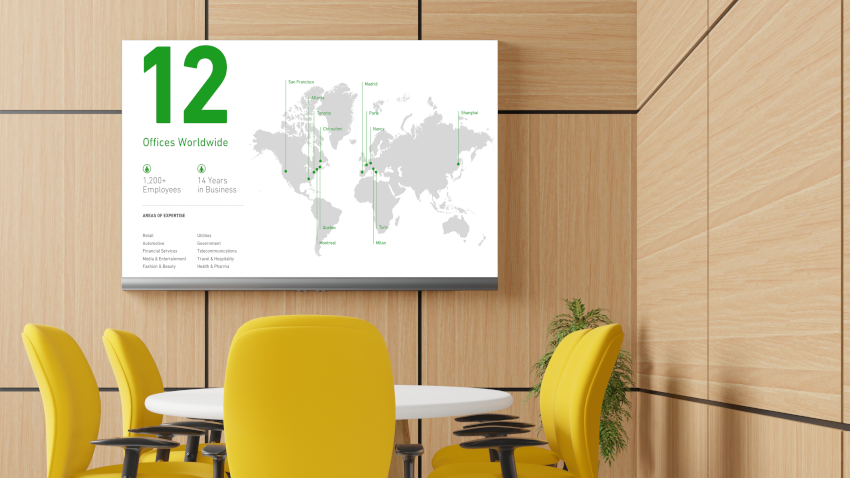Tips for Strategic Digital Signage Placement in Corporate Office Spaces
Digital signage placement in corporate office spaces can make or break your digital signage investment. The signs improve communication efficiency by providing a highly-visible internal communication channel for information sharing. For example, digital signage enhances internal communication, which leads to 25% higher employee productivity. As such, they keep the customers and employees in the know-how.
With this in mind, selecting the most suitable location for your digital signs calls for strategic planning. Conference rooms, break rooms, staff cafeterias, and waiting rooms can benefit from digital signs. This guide discusses all that goes into digital signage placement in corporate office spaces.

Digital Signage Placement Considerations
One of the most crucial factors in a digital signage project is location. More precisely, buying a digital display and mounting it on a wall isn’t enough to win over your audience. Instead, you should carefully think about the positioning and placement of your digital displays. Your final decision should meet the overall objective of your project.
With this in mind, here are crucial points to remember when deciding about your digital signage placement and positioning.
The Content Determines the Location
The first thing to do when deciding the location of your screens is to analyze the content you want to display. Who is your audience, and what information do you want to pass to them?
For example, if you intend to share updates with all employees, a display positioned in the entranceway will likely attract everyone’s attention. Similarly, if you want to display interactive digital signage content, place your digital menu boards in areas where people are likely to stop and wait. Remember, disengaged employees are 12x more likely to leave their job within the current year. If employees are your audience, place your signage in places where they can interact positively with them.
The best place to start is by determining the overall goal of your digital signage systems. Then, you can plan out how you want people to view and interact with the content. Next, determine the position that best links the displays to the intended purpose.
Choose High-Foot Traffic Areas
Before making the final decision about where to place your digital signage, walk around your space. The aim is to study the floor plan while paying attention to the high traffic areas. Likewise, it would be helpful to determine where your eyes naturally go upon entering a space. That’s probably a good location for digital signage placement. Consider the following factors:
- Is this a place where people are usually in transit or wait for extended periods?
- Where do people tend to stop often? Are there common locations where they mostly hang around?
- Does the area have any obstacles that would block your digital signage screen? For example, are there dividing walls, pillars, or staircases that would limit visibility? If so, you need to be creative in mounting your displays.
A location where people spend more time waiting or in transit would be ideal for digital signage placement. Collecting all this information may seem tedious. However, it’ll go a long way in informing your digital signage placement decision.
Consider the Surroundings
Your surroundings can make or break your digital signage project. For example, if you position your displays in meeting rooms, the chances are high they’ll not hold the intended audience’s attention for long. People may not occupy meeting rooms throughout the day, which means the content will go to waste.

For greater success, position your displays where people spend most of their time in transit, waiting, or working. Besides, ensure the surrounding is free of other items competing for people’s attention. Here’s a sure way to grab your employee’s attention.
Keep in mind that your surroundings are an asset, and finding the best way to leverage them can be advantageous. As a tip, avoid having your displays sticking out like a sore thumb. Instead, get creative and see how you can elegantly integrate the signs within your space. The best outcome would be to let your digital signage installations integrate themselves in an unobtrusive but outstanding way.
The Viewing Height Matters
The height at which you place your digital signs matters. Regardless of how engaging your content is, placing the screens outside the field of vision will be counteractive. The safe distance for digital signage should be at the average eye level where everyone can see and interact with it. If you place the screens below aye level, ensure you angle them slightly upward. Likewise, those you place above eye level should have a slight downward angle.
A crucial thing to remember is that a person with normal vision can see clearly for up to 20 to 23 feet ahead. On average, it takes 5 to 7 seconds to walk that distance. Conversely, a digital display screen positioned at that distance allows you a window of 5 to 7 seconds to pass your message across. Correspondingly, a display positioned far above eye level has a much shorter engagement window. That’s because the field of view decreases as the viewer gets closer to the screen.
When considering the viewing height, pay attention to ADA compliance guidelines. Some of them point out that signs:
- May not block entries, exits, or emergency doors and equipment
- Must be at least 80 inches above the floor when hanging from the ceiling
- Projecting from the wall must be at least 27 inches above the floor and only 4 inches out of the wall into the hallway
Digital Signage Placement Options
When deciding on digital signage placement, consider the most suitable location options. These include:
- Interior walls and columns: They’re among the most common places you’ll see digital signage displays. The signs flush against a surface or take a corner position to face the audience. Additionally, the displays feature broad messaging and have a strategic position in high-traffic areas.
- Waiting areas: Your customers and visitors to your business will largely benefit from digital signage placement in areas where they experience downtimes. For example, digital signage can reduce the perceived waiting times in lobbies and waiting rooms. While designing content for these areas, ensure it matches the average wait time. As a tip, it can be a combination of educational and entertainment content.
- Changing rooms, elevators, or other empty spaces: Most corporate offices and business locations have several unique areas. Examples include elevators or changing rooms. Here, digital signage placement can capture the audience’s attention in an otherwise empty but highly-trafficked area.
- Employee break rooms: Your digital signage solutions don’t always have to target your customers. After all, you employees can also enjoy informational, educational, or entertaining digital signage content. Think of how to enhance break rooms and various work areas with digital signs.

With all these factors to consider, keep in mind that digital signage placement isn’t about the availability of some space that needs filling. Instead, you want to be strategic about them, placing them where they’ll have the most impact on the intended audience.
Maximize Your Corporate Digital Signage
Digital signage displays play a crucial role in helping you leverage your market strategy or enhance your company culture. However, not getting digital signage placement and positioning right can mess up the entire project. As such, ensure you place them in high traffic areas and within the normal field of view, considering several factors within the environment. Don’t forget that the content of your displays will also determine where you place them to reach the target audience.
Want to learn more about digital signage? Click here to read more articles on our Digital Signage Insights page!


